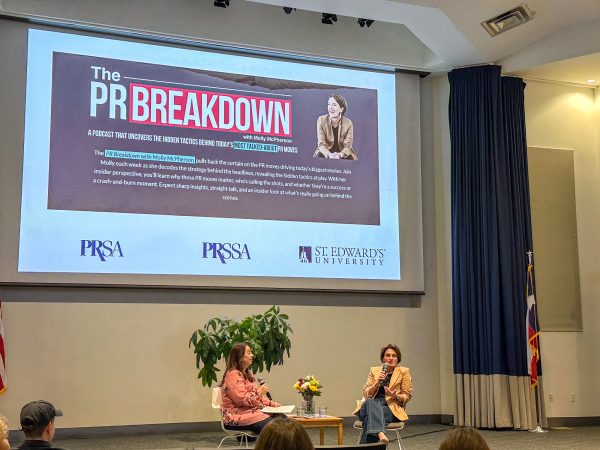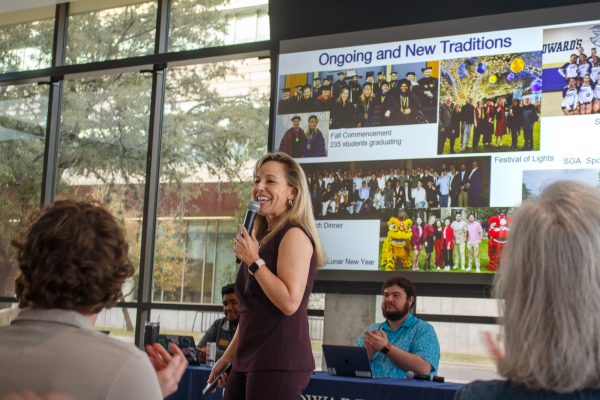Professor presents black hole research
Paul Walter, assistant professor of science in the School of Natural Sciences, shared his research on binary black hole mergers. He presented his research at the Faculty Talk Series on Friday at St. Edward’s University, sponsored by the Center for Teaching Excellence on April 13.
To begin his presentation, Walter introduced the complex subject matter with a simple analogy: a black hole coin funnel.
Once a coin is tossed into the model, it continues to spin until it loses energy. The more the coin spirals around the funnel, the faster it goes. In other words, the coin gains a higher frequency of orbits.
As the coin travels faster and faster around the model, it is also working its way down into the funnel. This is what happens when an object is sucked into a black hole.
“Because a coin has friction, it loses energy and end spirals until a point of no return,” Walter said.
Walter said that an American theoretical physicist, John Wheeler, helped restore interest in general relativity in the 1960s. This theory states that the curvature of spacetime — the union of space and time — is directly related to the energy and momentum of whatever matter and radiation are present.
“Matter inversely tells space how it’s going to curve,” Walter said. “The closer an object is to the sun, the force gets larger and the curvature gets more extreme.”
A black hole is formed during the final stages of a massive star’s life. It can become so dense it cannot hold up under its own gravity. The star then collapses under its own weight. Not all stars, however, leave behind a black hole remnant when they die. Only those massive enough will.
“There becomes so much mass in a tiny space, that it cannot hold itself up anymore,” Walter said.
This collapse results in a single, infinitely dense point.
“Nothing can escape within the distance of the event horizon,” Walter said.
Black holes can orbit each other and eventually merge into a larger black hole. During this process, gravitational waves are generated and ripple through space.
“The more compact and massive the objects are and the more they accelerate, the larger the emission of gravitational waves,” Walter said. “Binary black hole mergers will be the largest source of gravitational waves.”
Gravitational waves provide information about how the sources are moving. As two black holes orbit each other, they are pulling at each other and accelerating with the same force. This emits a lot of energy.
“When a black hole is ten times the mass of the sun, they can orbit themselves at 100 times per second,” Walter said.” This is an extremely energetic event.”
Though the detection of gravitational waves can help astronomers locate black holes, they have never been directly detected.
“Nothing has been found yet,” Walter said. “It will be toward the end of this decade when the detectors will be advanced enough to find signals.”
Astronomers have monitored the orbital frequency of the binary neutron star system since 1974, according to Annenberg Learner. Astrophysicists use the arrival times of the radio pulses to reconstruct the orbit of the binary system. This is indirect evidence that gravitational radiation exists.
“We will likely be able to directly detect gravitational waves by 2020,” Walter said. “If there was an event close enough to us, we would have measured it by now.”
Detecting gravitational waves is difficult, but it still vital.
“We are detecting something that is extremely difficult to measure,” Walter said. “The signals are going to be very weak. What a wave form looks like is telling us about the dynamics of the source that is making that wave.”
By the end of the decade we should see a great advancement in this field, Walter said.
“The direct detection of gravitational waves will open a new portal into how we are able to view the universe,” Walter said. “We will be able to map out the universe.”
St. Edward’s encourages undergraduate research.
“The goal is to get students interested in research,” Walter said.
However, professors may find it difficult to conduct their research because of the four course minimum they must teach. Walter dedicates time for his research during the summer months and winter break.
“My responsibilities are to teach,” Walter said. “I conduct my research on my own time and at my own will.”
Though St. Edward’s offers fewer resources for faculty, Walter received a summer grant in 2011 from the Office of Sponsored Programs that was put toward his research.
St. Edward’s currently does not offer a major in physics; however, Walter would like to help build the physics education track and encourage students to get involved with the subject matter.






